Art of the Genre: An Interview with Stephen Hickman
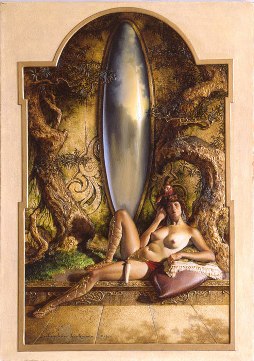 You know, life in LA is never easy, we all just make it look that way. I guess that’s why a few months back I got a rather rude awakening from none other than John Hocking. I’d just gotten back in from completing the Michael Whelan assignment, and considering everything that went into that, I was feeling pretty stoked.
You know, life in LA is never easy, we all just make it look that way. I guess that’s why a few months back I got a rather rude awakening from none other than John Hocking. I’d just gotten back in from completing the Michael Whelan assignment, and considering everything that went into that, I was feeling pretty stoked.
The interview finally goes to press, I pop open the Champaign, and then what happens? Hocking rings me and asks when I’m doing a Stephen Hickman interview. Hmmmm, at that moment I felt like an NFL quarterback who just won the Super Bowl, goes off the field to the locker room to celebrate and has the owner pull him aside and ask, ‘what are you going to do next season that will get us back here?’
I mean come on! Can a guy get a moment to bask in the glory? Well, the answer is no, not here at BG L.A… The next thing I know O’Neill is calling, Kandline sits crying at the reception desk over a failed casting call, and Ryan Harvey won’t stop pestering me that he’s a published fiction writer so he should have the bigger oceanfront office. Yep, business as usual…
What does O’Neill want? Well, he’s also heard from Hocking and those two masterminds have determined I need to go to Colorado and meet with artist extraordinaire Stephen Hickman while he’s on vacation in the area visiting his daughter.
So an expense check clears, packages are exchanged, a phone call is made, and I find myself once again on a plane out of LAX, this time bound for the Centennial State. Colorado this time of year is a really beautiful place, and even more so when you get out of Denver and make your way up the 36 to Boulder.
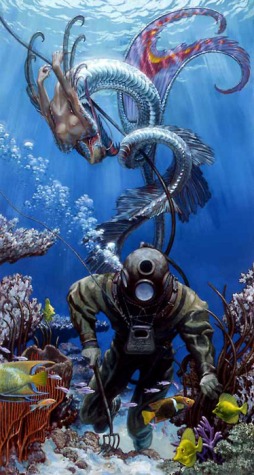 There I met Stephen at Ted’s Montana Grill. Now Stephen purports that he has a tender stomach these days, but Ted’s treated us right. Let me tell you, I love eating all types of food, as my travels will show, but if you set me down at a true-blood American steak house, you better watch out! I’m pretty sure at some point I blacked out during the eating fest, but I’ll try to break it down for you… grilled shrimp appetizer with some salt-N-pepper onion rings, George’s Cadillac burger served with a side of cheese fries and ranch dressing, and to finish it off a Kahlua Fudge Brownie. Mmmmmmm, good!
There I met Stephen at Ted’s Montana Grill. Now Stephen purports that he has a tender stomach these days, but Ted’s treated us right. Let me tell you, I love eating all types of food, as my travels will show, but if you set me down at a true-blood American steak house, you better watch out! I’m pretty sure at some point I blacked out during the eating fest, but I’ll try to break it down for you… grilled shrimp appetizer with some salt-N-pepper onion rings, George’s Cadillac burger served with a side of cheese fries and ranch dressing, and to finish it off a Kahlua Fudge Brownie. Mmmmmmm, good!
I know; it’s amazing I still had the stamina to do the interview, but I’m not BG’s top reporter because I’ve got a weak constitution. Besides, knowing the bill for the meal would be on O’Neill’s desk in Chicago Monday morning made every bite worth it.
Stephen, to his credit, humored my appetite and I found him to be incredibly engaging. He’s a talkative character, someone with an almost encyclopedic mind, and our conversation kept me on my toes all the way through desert.
Once we’d completed the rounds of the casual stuff and simple getting to know one another dialogue, we finally settled into an interview for the ages. Before we get started, however, let me first thank John Hocking for getting the ball rolling on this whole thing. Without his ability to never accept victory as an end but only the beginning, I’d never have had the chance to meet such a wonderful artist and man.
An Interview With Stephen Hickman
Conducted and transcribed by Scott Taylor, Late July 2011
.
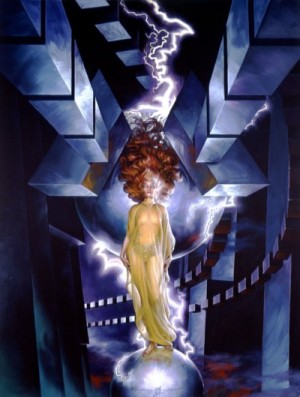 BG: It’s said the turning point in your artistic career came when you met Frank Frazetta and Roy G Krenkel in 1967. We’ve all had our ‘fan moments’, can you give us some personal insight into how you felt during that encounter?
BG: It’s said the turning point in your artistic career came when you met Frank Frazetta and Roy G Krenkel in 1967. We’ve all had our ‘fan moments’, can you give us some personal insight into how you felt during that encounter?
SH: I can remember Mike Kaluta and I were doing illustrations in Virginia Commonwealth University and decided to go to a comic convention in New York City. It was my first time in the city, and while there we ran into Roy C. Krenkel. He was like Doc Brown, Christopher Lloyd’s character in Back to the Future, only more eccentric and interesting. Roy looked at our work and turned us on to Frank Frazetta, who was doing his first convention at the time. Both our work was horrible, but Frank took the time to look at it and gave us encouragement. The interaction we got from them turned both Kaluta and me into complete tunnel vision characters focused only on art, and we never stopped.
That experience, and Alphonse Mucha book we found in the library, were the epiphanies of another sort that pushed me to do what I do.
BG: If someone said ‘I like the color of your painting’, what do you think they mean?
SH: You have to consider who is talking to you. If the observer has a trained eye and some education on the subject, then they will be talking about the ‘rules’ you’ve employed. If they’re untrained, then they will be speaking about how the piece moves them. As a note, I see any question like this, especially from a trained eye, actually speaking about the harmony of the image. It’s like watching an unfinished movie in the cutting room without the soundtrack. Color in an image should have the same kind of subconscious impact as a soundtrack, giving flavor to the emotion of the piece that never overwhelms, but without it the art is wholly incomplete.
BG: If you’re doing a book cover, and you have the scene picked out, one with characters involved, where do you start, the people or the landscape, and why?
SH: It’s about ‘Artistic Vision’. Frazetta once said he would sit and think about each Conan cover for a week before he’d begin them (Krenkel told us that he thought Frank saw things more ‘roundly’). All-in-all the idea is the most important feature. Each time you sit down to work it’s different. Sometimes the images appear, sometimes you have to do sketches, try things, and sometimes you begin and up until the point of finishing struggle with it. I’ve gotten to the point of near completion and had to call an editor and say my image wasn’t right and I needed to redo it. It was then I found out there was more wiggle room on deadlines, but when I repainted it, the work was so much better. The worst thing that can happen is to see your work as year later, after publication, and think ‘oh man, NOW I know what I should have done’.
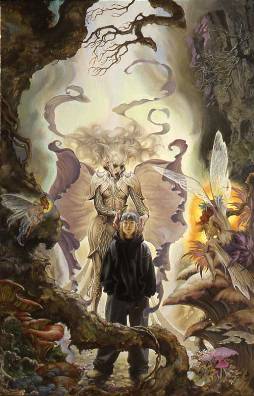 BG: Do you own any original art that isn’t yours?
BG: Do you own any original art that isn’t yours?
SH: My walls are so packed with images, it’s a great complement to find a place on them, but I do have a few. I have several Ivan Shishkin prints, a magnificent Alphonse Mucha poster from Prague, as well as several by Charles Vess. I also have two Kaluta drawings, and three by Phil Trumbo, a fellow luminary from Richmond.
BG: Is there a place in the world you haven’t been that you’d like to see, why?
SH: I traveled a great deal when I was growing up as my father was in the Foreign Service. I must say that once you travel in so many different cultures it’s easy to see how bigotry takes place in a kind of ‘blame your own shortcomings on others’ mentality; once you know something about the other guy, you know more about yourself. Still, Manila in the Philippines was beautiful when we were there, and I drew a great deal from that, especially when I did my own book. When I first started doing covers, probably for the first half of my career, it seemed that all fantasy was set in a European renaissance fair, and I longed to see fantasy in other parts of the world. Luckily for me, more recently I’ve been getting great authors to do covers for, authors who’ve changed that fantasy and SF stereotype of a Euro norm. I’m not sure there is still someplace I’d like to go now, maybe Australia or New Zealand, but I do have wild memories of Pakistan that when I was a kid in the 60s — it was something out of a Rudyard Kipling novel then, but has gotten a bit out of hand lately.
BG: You felt the need to move from being a pure painter to another form of artistic expression; that of writing with the creation of the 1988 book The Lemurian Stone. Can you tell me something about that process and why you felt you needed to do so?
SH: I think I did it because I had a conviction that I could do it. My father was an English Teacher at one point, and he wrote a memoir of his experiences flying P-51s in the Air Corps in WWII as well as his escape from German forces when he was shot down. That writing helped move me to do it. I had such deep impressions in Manila, and that was a great inspiration. And after a lapse of nearly twenty-five years I’m writing again: I’m more than half-way through the sequel, with three other ideas lined out.
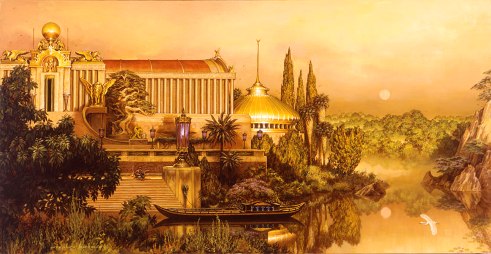
BG: One of your more renowned pieces, ‘The Lion Pavilion’, came from your book. Can you give us a little info on the creation of that piece?
SH: It was a kind of poetic vision that could be part of a story. I was thinking about images, paintings, it’s how I work, laying out each scene in my mind like a movie storyboard. That image is a kind of summer palace, something located in the northern isles.
BG: All artists differ in their daily regimes. Can you take us through a typical ‘painting day’ with you from dawn to dusk?
SH: When you’re a freelance artist, it like being your own ringmaster and the circus is inside your head. When I was young and had children in the house, I’d take the ‘vampire shift’ to have peace and quiet, though trying to sleep through the daytime wasn’t easy until I was told about ear plugs — it’s a lot easier to work when you’re not sleep-deprived! Now, with children out of the house, it’s still about self discipline, but with a more normal schedule. A lot of what I do now is done while listening to books on tape, which keeps me from going stir-crazy while I’m working endless hours.
BG: I always feel visually motivated to create when I travel, the juxtaposition between poverty, riches, and nature spurring my creative spirit. Is there anything that you know of that typically motivates you to create something? I.E. which of your senses do you credit with artistic inspiration?
SH: There are two psychological states of mind, that of being in your repetitive ‘house self’ which is cushioned by a series of responses and patterns, and of your ‘travel self’ which thinks differently as you move about and experience new things. This later self helps in the inspiration and creative side of your being. I enjoy writing while in transit, and when you meet people, they also expand you vision, even the obnoxious ones. (Actually obnoxious people, especially those who don’t even know they are obnoxious, are some of the best grist for the writer’s mill).
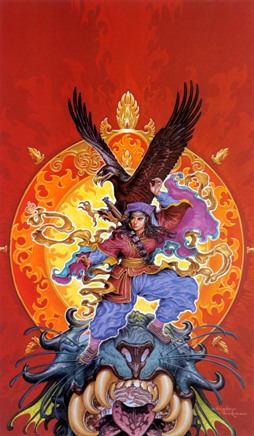 Also, on a personal note, I enjoy planes, especially WWI and WWII planes (really ALL planes), the lines of modern aircraft like the F-105 and MiG19 reminding me of Rocky Jones, Space Ranger. The functional lines of planes are an inspiration, and it was building models of these that I first developed a sense of aerodynamic beauty that planes have. Then there were movies such as The 7th Voyage of Sinbad that helped inspire me to do art, as have many others.
Also, on a personal note, I enjoy planes, especially WWI and WWII planes (really ALL planes), the lines of modern aircraft like the F-105 and MiG19 reminding me of Rocky Jones, Space Ranger. The functional lines of planes are an inspiration, and it was building models of these that I first developed a sense of aerodynamic beauty that planes have. Then there were movies such as The 7th Voyage of Sinbad that helped inspire me to do art, as have many others.
BG: You did the covers for Larry Niven’s Man-Kzin Wars. Can you speak a bit about the creation of the Kzin?
SH: When Jim Baen asked me ‘Do you want to do a series?’ I’d thought about it, and of course said yes. When I started them I wanted to NOT read them at all, and to ‘illustrate the metaphor’ (as Roy Krenkel would have said), thinking that this would make things easier in the long run. And it worked, having now done 13 covers for these anthologies. It wasn’t until about the 3rd volume that I actually read a story, and I was knocked out by how good it was (when I was in high school, short stories were mostly things that weren’t good enough to be made into books, but these stories were outstanding). It’s also funny that after reading them, I noted that my covers were actually inspiring short stories in later volumes, so each cover was actually one book ahead of the actual story that reflected it. This was the first time I’d seen my art inspire writing, but it was great! I still love doing these books today, although I now illustrate from the stories. Still, they don’t attach names to the stories they send me, probably to avoid me showing favoritism in the cover selection.
This was also the first time an editor called me to tell me they loved a cover I’d done. Editors and publishers just don’t do that, you know, but these covers really sold books and did very well, so I guess in this case I got the covers right.
BG: Do you ever talk to authors before you do a cover?
SH: I love to talk to authors, and when I talk to them I like to get their own emotional responses to their stories. This helps me place what they are looking for. When we were pressed for time for a cover on a short-story collection, I called the author, John Ringo, and he gave me plot outlines over the phone. I got a flash off one of them, and I described what I was seeing for it and he said ‘Great, I still have the story in my computer, that’s the way I’ll describe it’.
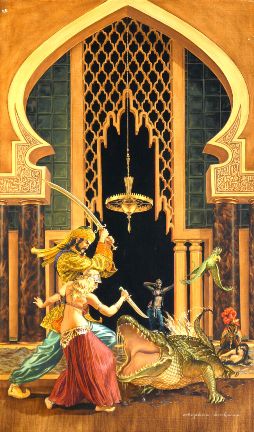 BG: You went to school with Mike Kaluta, a master in his own right. Do you have any good stories concerning your time together?
BG: You went to school with Mike Kaluta, a master in his own right. Do you have any good stories concerning your time together?
SH: Virginia Commonwealth in Richmond was a bohemian paradise in the late sixties, kind of like the east coast San Francisco. It was so early in its development and booming with new students that you were given addresses to classes because signs weren’t even up yet. Mike and I were obsessed with art, and nothing our instructors had to say was teaching us anything. I went to one class and drew a globe that was split and angled for perspective. When the teacher saw it he said ‘well, you don’t need to come back to class for another six weeks’. We both simply spent all night drawing, listening to Kaluta’s ancient record player. Folk tunes, some Beatles, Rolling Stones, and Bob Dylan (Mike was forever quoting Dylan lyrics like they meant something), the Doors, Jefferson Airplane. Mike was always talking comics, especially these Edgar Rice Burroughs-type storylines he made up that changed almost as quickly as he told them. I learned to tune most of it out (had to do it), but we never gave up, and he’s got to be the single most brilliant comic stylist on the planet at this point.
BG: If you had a nephew or niece who wanted to become a freelance artist, what honest advice would you give them? Remember, this is someone you care about!
SH: Frank Kelly Freas would tell people ‘if you can do anything else at all…’ A part of me wants to second that, but Frazetta didn’t discourage Kaluta and me, even if we were horrible at the time. I say it’s a calling, something that you absolutely and whole-heartedly need to feel you have to do it. Joseph Campbell in Mythology and the Individual would say that if that’s what you were born to do, it will happen for you, in an almost mystical fashion. I’ve spent over forty years doing this, have done God knows how many covers, and quite a number of private commissions, and I feel like I’ve been living on the edge of oblivion my entire life. That’s not to say don’t enjoy it, but you have to truly want it. Still, try to do something in movies or video games, this cover art industry is changing and there won’t be cover work that much longer.
BG: Are you more a reader or a movie guy? If you’re a reader do you have a favorite sci-fi or fantasy book? Likewise, if you answered movie, what is your movie of choice from that genre?
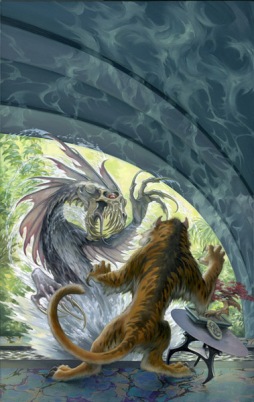 SH: Both. I love books on tape, and have memorized over a dozen of my favorite books. My wife Vicki and I are ‘first nighters’ on almost all new movies. I have to say that movies today, at this time, are becoming increasingly good. It’s said that troubled times generate intensely creative work, the creative spirit, when challenged, becomes more developed. It was true in Renaissance Italy where political powers were always in flux; and in Shakespeare’s most prominent years during a famine, not to mention that the theatres were filled to capacity every night (even despite a curfew). And we saw it in the Great Depression when movies were the only industry thriving and growing in the U.S.
SH: Both. I love books on tape, and have memorized over a dozen of my favorite books. My wife Vicki and I are ‘first nighters’ on almost all new movies. I have to say that movies today, at this time, are becoming increasingly good. It’s said that troubled times generate intensely creative work, the creative spirit, when challenged, becomes more developed. It was true in Renaissance Italy where political powers were always in flux; and in Shakespeare’s most prominent years during a famine, not to mention that the theatres were filled to capacity every night (even despite a curfew). And we saw it in the Great Depression when movies were the only industry thriving and growing in the U.S.
BG: Would you consider digital art ‘real’ art?
SH: Absolutely — it’s just a different medium. This same question was probably asked at the advent of egg tempera painting, and then oil. It was also asked if phonographic recorded music was still music, and was considered if movies were as ‘real’ as a live play, or something more synthetic.
BG: If you could give your younger self call, what would you say to him?
SH: I would say to myself, ‘Son, go out and invent the graphic novel instead of doing these covers’. And then I’d listen to myself argue … If I could have had my writing skills then, enough to do graphic novels, it would have been perfect. But I didn’t then know I could write, and didn’t draw nearly fast enough to support a family with comics.
BG: Did you ever have that ‘moment’ when you knew what you wanted to be, or did you grow into your field naturally?
SH: I’d say my art was more a product of obsession, a kind of reacting powerfully to harmonies in life. I was always doing artwork of some kind, like producing rubber horror masks and monster make-up, but when I saw the Ace covers by Krenkel and Frazetta my A.D.D. kicked in and everything changed.
BG: When you’re searching for a scene in a book for a cover, what do you look for?
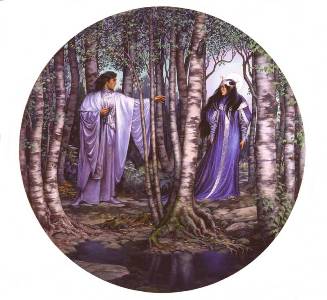 SH: I try to base it on something in the story, like a movie poster. I always look to three principles; Contrast, Clarity, and Color. Get their attention first and then capture them with color and detail. I will say that things have changed today, the marketplace has changed. Covers are now all about sales, and that’s all editors and authors care about. They don’t want what they might like or enjoy personally, they only care about me getting something right for the numbers so that they can keep on doing their jobs. It’s sad, because it’s like the Neilson Rating System. If you don’t get the numbers right off the bat, you’re dead, but you have to remember that classic shows like I Love Lucy wouldn’t have even lasted a full season if ratings were in effect then, and yet they are iconic in today’s mind. There are no second chances or long tails anymore, so covers have to be about selling books.
SH: I try to base it on something in the story, like a movie poster. I always look to three principles; Contrast, Clarity, and Color. Get their attention first and then capture them with color and detail. I will say that things have changed today, the marketplace has changed. Covers are now all about sales, and that’s all editors and authors care about. They don’t want what they might like or enjoy personally, they only care about me getting something right for the numbers so that they can keep on doing their jobs. It’s sad, because it’s like the Neilson Rating System. If you don’t get the numbers right off the bat, you’re dead, but you have to remember that classic shows like I Love Lucy wouldn’t have even lasted a full season if ratings were in effect then, and yet they are iconic in today’s mind. There are no second chances or long tails anymore, so covers have to be about selling books.
BG: When was the point when you knew you’d ‘made it’, assuming you’ve ever felt that way?
SH: I’m still not sure I’ve made it, but it was a real eye opener when I started getting in touch with artists on Facebook, and finding out they knew my work and got a kick out of it. I have to say that kind of feedback to my work keeps me going through the years, and private commissions are the most fun work that I do.
BG: What’s your favorite color? Does it influence what you paint?
SH: This was by far your easiest question. Blue-violet; and it doesn’t influence anything, really…
BG: Describe your work space? Paints at hand, brushes, materials, visual aids, do you have a view, etc.
SH: I work in a large room with a fireplace that goes unlit, with a mantel filled with stuff. I like lots of light and have great ventilation. My view once looked out on a copse of birch trees that inspired the image in The Meeting of Aragorn and Arwen, but they passed their life span and are now gone. I can still look out into our acres of land in the Hudson Valley and see our three-hundred year old red oak, which is a fine view.
Well, much to my, and I hope your, sadness that’s the end of this journey. Stephen was a pleasure to speak with, and I hope you enjoyed some of the thoughtful insight he brought to this interview. After the wrap, as always, it’s back to L.A., and let’s hope Hocking isn’t already waiting on the phone with another request.
Great work, Scott! Geez, all I did was make a casual remark after enthusing about your Whelan post. If it led to this I’m purely delighted.
I knew almost nothing about Hickman’s history with Kaluta, and his revelations about his craft are inspiring.
Hickman has one of the most distinctive styles in genre art– you can spot his work a mile away. Lush, vivid and unforgettable.
Thanks again, Scott. You go…um…rest up and treat yourself to the beverage of your choice.
Thanks John, I’m glad you enjoyed it. It’s always fun to have someone throw out a name and see if I can land them 😉
Stephen Hickman is new to me. Thanks!
Never a prob Theo! And as always, great to see you!
[…] Interview: Black Gate interviews fantasy artist Stephen Hickman […]